MAJOR COMBAT OPERATIONS ON LEYTE WIND DOWN
Tacloban, Leyte Island, Philippines • December 30, 1944
The island of Leyte, the first island in the Philippine archipelago captured by returning GIs, was securely in U.S. hands by this date in 1944. It only remained for Gen. Douglas MacArthur, Supreme Commander of the Southwest Pacific Area, to announce the end of organized Japanese unit resistance, which he did the next day.
Leyte was neither the Philippines’ most populous island (at 900,000 people) nor its most economically important—that distinction belonged to Luzon, the site of the Philippine capital, Manila, over 600 miles/966 km to the north. What attracted the army commander to Leyte was its deep-water approaches on the east side and its sandy beaches, which offered opportunities for amphibious assaults and close-in resupply operations. On October 20, 1944, following 4 hours of ferocious U.S. naval bombardment, Lt. Gen. Walter Krueger’s Sixth Army forces stormed their assigned beaches. Early that afternoon Gen. MacArthur waded through the surf just south of Tacloban, Leyte’s capital and largest city (see map), to speak into the microphone of a portable radio transmitter and say, “People of the Philippines: I have returned!”
At the time of the Leyte invasion the Japanese occupation army numbered 20,000. As Krueger’s soldiers (eventually 200,000), assisted by 3,000 Filipino guerrillas, pushed inland from the east, beating back the foe, the Japanese responded by landing around 34,000 troops and over 10,000 tons of materiél on the west side of the island between November 8 and December 3 in the absence of dominant U.S. air and naval power in that area. Ormoc City at the head of Ormoc Bay was the island’s main port and the main destination of Japanese reinforcement and resupply convoys. (Ormoc lies in the center of the map below.) A series of fierce air and naval battles between U.S. and Japanese forces off Leyte’s east coast (Battle of Leyte Gulf, October 23–26, 1944) and later west coast (Battle of Ormoc Bay, November 11 to December 21) combined to inflict the greatest loss of ships and crew ever on the Imperial Japanese Navy.
But Krueger’s men still had to take physical possession of Leyte’s west coast, which the Japanese had lightly fortified. On December 7 Krueger landed 8,500 men and equipment of his reserve 77th Infantry “Statue of Liberty” Division near Ormoc City to interdict Japanese reinforcements, envelop the now cut-off forces, and exterminate the enemy. The U.S. amphibious landing, the second on Leyte, was unopposed but subjected to kamikaze air attacks. Three days later the port of Ormoc was in U.S. hands. On December 14, artillery barrages, flamethrowers, armored bulldozers, and hand-to-hand combat wore down enemy resistance, resulting in the 77th Division killing just over 1,500 enemy soldiers. In the second half of December organized Japanese combat units crumbled almost everywhere on Leyte Island, though enemy pockets and stragglers continued to be mopped up until early May 1945, long past the U.S. invasion of the main island of Luzon and the capture of Manilla.
Two and One-Half-Month Battle of Leyte: First and Most Decisive Step in Recapturing and Liberating the Philippines
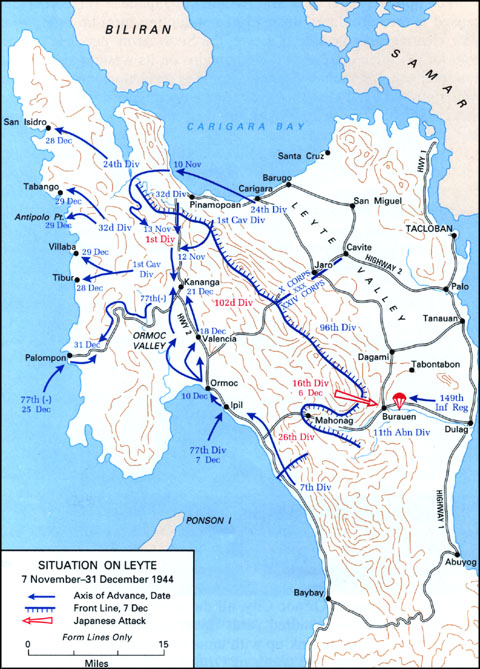 |
Above: Map of Leyte Island from the waist up. The Leyte Campaign cost the Japanese an estimated 49,000 mostly combat forces. U.S. losses included 13,399 battle and 13,410 non-battle casualties. Of these, the 77th Infantry Division suffered 431 killed, 1,553, wounded, and 2,999 non-battle casualties. The relatively large number of non-battle casualties indicates just how awful the combat arena was. An estimated 25,000 malnourished, diseased, and dispirited enemy troops survived on Leyte into 1945, for the most part bottled up in several pockets. Once the decisive Battle of Leyte ended on December 31, 1944, many leading Japanese gave up all hope of retaining the Philippines, in so doing conceding to the Allies a critical bastion from which their home islands could be easily cut off from strategic mineral and agricultural resources in Southeast Asia and the East Indies (Philippine Archipelago, Indonesian Archipelago, Borneo, and New Guinea) and from which the final, bitter assault on Japan could be launched.
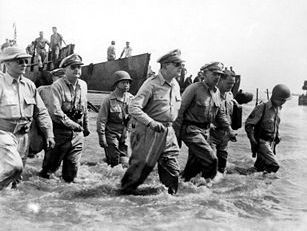 | 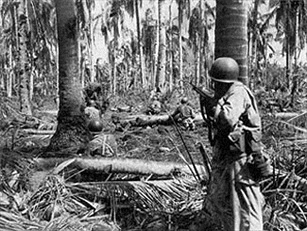 |
Left: Making a dramatic entrance, MacArthur was captured in this iconic photograph by Gaetano Faillace, the general’s personal photographer during the war. MacArthur, wearing his customary field marshal’s cap, crisply starched khakis, and sunglasses, was accompanied by Philippine President-in-exile Sergio Osmeña (left in pith helmet) and Lt. Gen. Richard Sutherland, MacArthur’s chief of staff (to the general’s left) as the men splashed through knee-deep surf onto Red Beach, just south of Leyte’s provincial capital, Tacloban, October 20, 1944.
![]()
Right: A squad of U.S. infantrymen cautiously advances on a Japanese machine-gun nest through dense, overgrown foliage. Sometimes when artillery from tank destroyers and mortars, automatic and small-arms fire, hand grenades, and flamethrowers failed to destroy or evict enemy resisters from their well-prepared and camouflaged pillboxes and foxholes, some of which were 7 ft./2.1 m below the surface, combat engineers resorted to using armored bulldozers to bury them alive before their unit renewed its advance. On other occasions GIs set up machine-gun kill zones and forced the enemy into them, which had the same deadly effect.
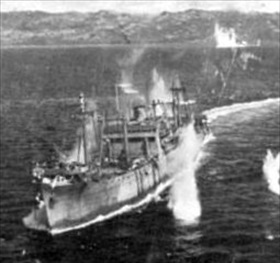 | 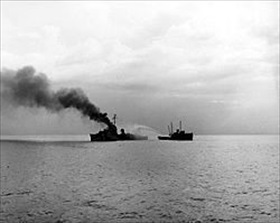 |
Left: Ormoc Bay was the principal Japanese funnel on Leyte Island for reinforcing and resupplying the small but determined enemy garrison at Ormoc City. The amphibious landings of 3 regiments from the 77th Infantry Division were unopposed, although U.S. naval vessels were subjected to kamikaze attacks. Overall, the Leyte Campaign cost the Japanese Navy 26 major warships and 46 merchantmen and transports like that pictured here being pummeled in Ormoc Bay. Japanese land-based air capability in the Philippines was cut by more than half, forcing the enemy to rely more and more on 1‑way suicide pilots. The 41‑day air-sea Battle of Ormoc Bay, mostly neglected by historians, was icing on the cake, bringing Leyte and the entire Gulf area under Allied control.
![]()
Right: Hit by a kamikaze, the U.S. destroyer Lamson is on fire in Ormoc Bay, Leyte, December 7, 1944, the day Krueger’s infantrymen debarked onto beaches just south of Ormoc City. A nearby tug assists with firefighting. The Lamson served as picket, patrol, and screening ship for MacArthur’s massive Leyte assault. The destroyer downed 2 twin-engine Mitsubishi Ki‑46s (“Dinahs”) before a third crashed into her superstructure, killing 25 crewmembers and injuring 54 others. The Lamson returned to war patrol and air-sea rescue work during the Battle of Iwo Jima (February 19 to March 26, 1945) and performed occupation duty following Japan’s unconditional surrender on September 2, 1945.
Contemporary Newsreel Account of MacArthur’s Landing on Leyte Island, Philippines, October 1944
![]()

 History buffs, there is good news! The Daily Chronicles of World War II is now available as an ebook for $4.99 on Amazon.com. Containing a year’s worth of dated entries from this website, the ebook brings the story of this tumultuous era to life in a compelling, authoritative, and succinct manner. Featuring inventive navigation aids, the ebook enables readers to instantly move forward or backward by month and date to different dated entries. Simple and elegant! Click
History buffs, there is good news! The Daily Chronicles of World War II is now available as an ebook for $4.99 on Amazon.com. Containing a year’s worth of dated entries from this website, the ebook brings the story of this tumultuous era to life in a compelling, authoritative, and succinct manner. Featuring inventive navigation aids, the ebook enables readers to instantly move forward or backward by month and date to different dated entries. Simple and elegant! Click 











